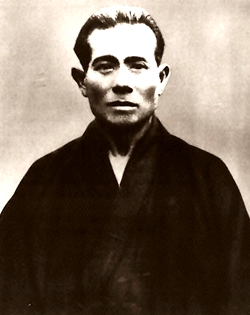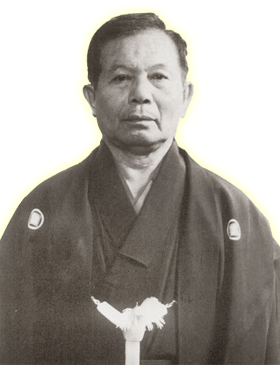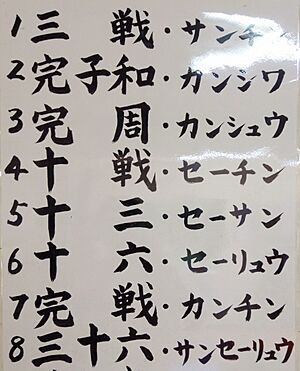Uechi-Ryū facts for kids
 |
|
|---|---|
| Country of origin | Okinawa (Japan) |
| Ancestor arts | Pangainoon • Fujian White Crane • Huzunquan • Naha-te |
Uechi-Ryū (上地流, Uechi-Ryū) is a traditional style of Okinawan karate. The name Uechi-Ryū means "Style of Uechi" or "School of Uechi."
This style was first called Pangai-noon. That name means "half-hard, half-soft" in English. It was later renamed Uechi-Ryū after its founder, Kanbun Uechi. Kanbun Uechi was from Okinawa. He went to Fuzhou in Fujian Province, China, when he was 19 years old. There, he studied martial arts and Chinese medicine.
After Kanbun Uechi passed away in 1948, his son, Kanei Uechi, helped improve, expand, and make the style well-known.
Contents
The Start of Uechi-Ryū

Kanbun Uechi learned Southern Chinese kung fu. He called his style Pangai-noon, which means "half-hard, half-soft." He trained with a teacher named Shū Shiwa (also known as Zhou Zihe) for about 10 years. Shū Shiwa also sold Chinese medicine.
In 1906, Kanbun Uechi opened his own school in Nanjing, China. He continued to train with Zhou Zihe for a total of 13 years. Three years later, Kanbun Uechi went back to Okinawa. He decided he would never teach martial arts again. This was because one of his Chinese students had accidentally hurt someone badly during a fight.
While in Okinawa, Kanbun Uechi did not teach his martial art. In 1912, a tea merchant and White Crane Kung Fu master named Go Kenki moved to Okinawa. Go Kenki knew Kanbun Uechi was a skilled martial artist. As word spread, people asked Kanbun Uechi to teach, but he still refused.
In 1924, when he was 47, Kanbun Uechi moved to Wakayama City, Japan, to find work. He worked as a security guard at a cotton spinning mill. A co-worker, Ryuyu Tomoyose, convinced him to teach privately. After two years, Ryuyu Tomoyose and about 30 other men persuaded Kanbun Uechi to start teaching again.
He taught in small rooms at the company dormitory. In 1932, he opened a general store and the "Pangai-noon Ryu Karate Academy" to the public. In 1940, he and his students, including his son Kanei, changed the name to "Uechi-Ryū Karate-Jutsu" to honor him.
Kanbun Uechi's son, Kanei Uechi, taught the style at the Futenma City Dojo in Okinawa. He was the first Okinawan to allow foreigners to learn the style. One of Kanei's students was an American serviceman named George Mattson. George Mattson wrote several books about Uechi-Ryū. He helped make the style popular in America.
Uechi-Ryū focuses on making the body tough. It uses quick punches and kicks. Some special moves in Uechi-Ryū are the one-knuckle punch (shōken zuki (小拳突き)), the spearhand (nukite (貫手突き)), and the front kick (shōmen geri (正面蹴り)) delivered with the first toe. People who practice Uechi-Ryū say it is good for self-defense. This is because it is simple, stable, and uses both straight and circular movements.
Unlike other karate styles that use more straight-line movements, Uechi-Ryū is influenced by Chinese Shorin-ken. This means it shares some basics with Naha-te and Gōjū-Ryū. Uechi-Ryū uses many circular movements from kung fu in Fujian province. The style is mainly based on the movements of three animals: the Tiger, the Dragon, and the Crane.
Kata: Pre-arranged Forms
There are eight empty-hand katas in Uechi-Ryū. Kata are like pre-arranged dances of martial arts moves. Only Sanchin, Seisan, and Sanseiryū came from the original Pangai-noon style. The others were created and added by Kanei Uechi and other senior students of Kanbun. Many of the newer kata names come from important people in the art. For example, Kanshiwa comes from Kanbun and Zhou Zihe's Japanese name, Shu Shiwa.
The kata are:
- Sanchin
- Kanshiwa
- Kanshū
- Seichin
- Seisan
- Seiryū
- Kanchin
- Sanseiryū
The Sanchin kata looks simple, but it teaches the basic moves of the style. This includes how to stand and how to breathe. Kanbun Uechi once said, "All is in Sanchin."
Here are the meanings of some kata names:
- Sanchin (三戦): Means "three fights" or "three conflicts." It is usually thought to mean "Mind, Body, and Spirit."
- Kanshiwa (完子和): This name combines parts of Kanbun's name and Shu Shiwa's name. It was created by Saburo Uehara in 1956.
- Kanshū (完周): This name combines parts of Kanbun's name and Shu Shiwa's family name. It was created by Seiki Itokazu in 1956.
- Seichin (十戦): Means "10 fights" or "10 conflicts." It was created by Saburo Uehara in the 1950s.
- Seisan (十三): Means "13." It is often thought to mean "Thirteen ways to attack and defend."
- Seiryū (十六): Means "16." It was created by Kanei Uechi in 1950.
- Kanchin (完戦): Combines Kanbun's first name character and "fight." It was created by Kanei Uechi in the 1950s.
- Sanseiryū (三十六): Means "36." It is sometimes thought to mean "36 ways to attack and defend."
Ranks in Uechi-Ryū
In Uechi-Ryū, students move up through different ranks. These ranks show how much they have learned and how skilled they are.
Beginner Ranks (Kyū)
There are ten beginner ranks, called Kyū. They count down from 10 to 1. White, green, and brown belts are common. Different schools might use slightly different belt colors or stripes for these ranks.
- 10º Jukyū (White Belt)
- 9º Kyukyū (White Belt with 1 Green Stripe; or Yellow Belt)
- 8º Hachikyū (White Belt with 2 Green Stripes; or Gold Belt)
- 7º Shichikyū (White Belt with 3 Green Stripes; or Blue Belt)
- 6º Rokkyū (White Belt with Solid Green Bar; or Green Belt)
- 5º Gokyū (Green Belt with no stripe; or Green Belt with 1 Stripe)
- 4º Yonkyū (Green Belt with 1 Brown Stripe; or Green Belt with 2 Stripes)
- 3º Sankyū (Brown Belt with 1 Black Stripe)
- 2º Nikyū (Brown Belt with 2 Black Stripes)
- 1º Ikkyū (Brown Belt with 3 Black Stripes)
Black Belt Ranks (Dan)
After the Kyū ranks, there are ten black belt ranks, called Dan grades.
- Shodan (1st degree | Regular Black belt)
- Nidan (2nd degree)
- Sandan (3rd degree)
- Yondan (4th degree)
- Godan (5th degree)
- Rokudan (6th degree) (Master's title: Renshi; Black belt with 1 Gold stripe)
- Nanadan (7th degree) (Master's title: Kyōshi; Black belt with 2 Gold stripes)
- Hachidan (8th degree) (Master's title: Kyōshi; Black belt with 3 Gold stripes)
- Kyūdan (9th degree) (Master's title: Hanshi; Black belt with 4 Gold stripes)
- Jūdan (10th degree) (Master's title: Hanshi; Black belt with 5 Gold stripes)
In the past, Okinawan styles used gold stripes on black belts to show master titles, not just ranks above 5th dan. For example, one gold stripe meant Renshi (錬士), two meant Kyōshi (教士), and three meant Hanshi (範士). In the early 2000s, many Okinawan styles started using stripes to show dan grades above godan. Many Uechi organizations now do this too.
Extra Training in Uechi-Ryū
Kanei Uechi not only added new kata but also introduced special exercises to Uechi-Ryū training.
Warm-up Exercises (Junbi Undō)
The junbi undō (準備運動, junbi undō) are warm-up and stretching exercises. They are based on training exercises used in Asian schools.
Some junbi undō exercises include:
- Ashisaki o ageru undō (足先を上げる運動) (heel pivot)
- Kakato o ageru undō (踵を上げる運動) (heel lift)
- Ashikubi o mawasu undō (足首を廻わす運動) (foot and ankle rotation)
- Hiza o mawasu undō (膝を廻わす運動) (knee circular bend)
- Kubi no nenten undō (首の捻転運動) (neck rotation)
Conditioning Exercises (Hojo Undō)
The hojo undō (補助運動, hojo undō) are special exercises that use moves from all the kata in the system. They also include other techniques.
Some hojo undō exercises include:
- Shōmen geri (正面蹴り) (Front kick)
- Seiken zuki (正拳突き) (Closed Fist Punch)
- Mawashi zuki (廻し突き) (Hook Punch)
- Hiji zuki (肘突き) (Elbow strikes)
- Shinkokyu (深呼吸) (Deep breathing)
Partner Drills (Yakusoku Kumite)
Uechi-Ryū also has pre-arranged sparring exercises called yakusoku kumite (約束組み手). In these drills, two partners practice a set series of blocks and strikes. These exercises help students learn how to use Uechi-Ryū techniques in real situations.
Kata Applications (Kata no Bunkai)
Practicing how kata moves are used in a fight is called kata no bunkai (型の分解). The Kanshiwa Bunkai and Seisan Bunkai have been around since Kanei Uechi's time. Different schools might create their own bunkai for other kata.
Strength Training
Uechi-Ryū training also includes special ways to build strength and condition the body.
- One exercise is kote kitae (小手鍛え), or "forearm tempering." This involves partners gently striking each other's forearms to make them stronger. Kanbun Uechi learned this in China.
- Similar exercises, called ashi kitae (足鍛え), or "leg tempering," are used for the legs.
- Uechi-Ryū also uses a makiwara (a padded post for striking).
- Other traditional Okinawan exercises are used, like putting hands into baskets of rocks or doing Sanchin kata while holding heavy ceramic jars called nigiri game (握り甕).
Uechi-Ryū Today
Like many martial arts, Uechi-Ryū saw some groups split off after its founder passed away. However, in 2018, the Okinawan government brought together leaders from some of the main Uechi-Ryū organizations. These include the Okinawan Karate-Dō Association, Kenyukai, Konan Ryū Shureikai, and the Uechi-Ryū Karate-Dō Association.
Pangai-noon
In 1978, some Uechi-Ryū students formed a new group and started using the old name Pangainoon Ryū. They wanted to teach kobudō (weapon arts) in their schools. Later, this style was renamed Konan Ryū. Today, some groups still use the name Pang Gai Noon Ryū to honor the original style.
Shōhei-Ryū
After Kanei Uechi passed away, many senior practitioners formed the Okinawa Karate-Dō Association. They were not allowed to use the Uechi family name. So, they renamed their system Shōhei-Ryū (昭平流). This name means "to shine brightly with fairness, equality, and peace."
The Okinawa Karate-Dō Association added new partner exercises and bunkai for the "Sanseiryū" kata. On September 18, 2016, the Okinawa Karate-Dō Association officially went back to using the name "Uechi-Ryū." This was partly to promote the style for the 2020 Summer Olympics.
Main Uechi-Ryū Organizations
Many Uechi-Ryū organizations have their main school in Okinawa and branches in other countries. Here are some of them:
Okinawa-based
- Jiteki (自適; "Self-Reliance") Jyuku Association
- Kenyukai (拳優会; International Kenyukai Association)
- Konan Ryū Shureikai (硬軟流守礼会)
- Okikukai (沖空会 沖縄空手道協会; The Okinawa Karate Dō Association)
- Okinawa Karate-Dō Uechi-Ryū Zankai (Zakimi Shūbukan 座喜味修武館)
- Okinawa Kōburyū Karatedō Kobudō Kōbukai (沖縄孝武流空手道古武道孝武会)
- Okinawa Konan Ryū Karate Dō Association (沖縄硬軟流空手道協会)
- Okinawa Konan Ryū Karate-do Renseikai (沖縄硬軟流空手道練成会)
- Okinawa Uechi-Ryū Hozonkai (沖縄上地流唐手道保存会)
- Uechi-Ryū Karate-Dō Association (上地流空手道協会)
- Uechi-Ryū Karate-Dō Ken Sei Kai (上地流唐手道拳誠会)
- Uechi-Ryū Karate-Dō Shinkokai (上地流空手道振興会修武館)
International Organizations
- Canadian Uechi-Ryū Karate Association
- International Uechi-Ryū Karate-Dō Association (IUKA) (Kokusai Kyokai)
- International Uechi-Ryū Karate-Dō Shubukai (上地流空手道修武会)
- International Uechi-Ryū Karate Federation (IUKF)
- North American Jiteki-Jyuku Karate Association
- Ryukokaku Karate and Kobudō Association (龍虎鶴唐手古武道会; "Dragon, Tiger, Crane, Toudi and Kobudo Kai")
- Uechi-Ryū Bushidō
- Uechi-Ryū Butokukai
- Uechi-Ryū International Karate-Do Association (UIKA)
- Uechi-Ryu Karate-Do Association (GB)
- Uechi-Ryū Karate-Dō Shinkokai Shūbukan (上地流空手道振興会修文)
- Uechi-Ryū Karate Dō Europe
- União e Força Brasil Karate-Do
- World Uechi-Ryū Karate Dō Kobudō Organization (WUKKO)



